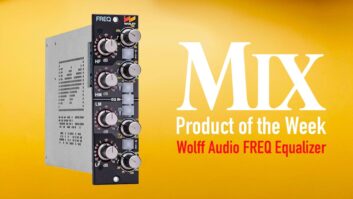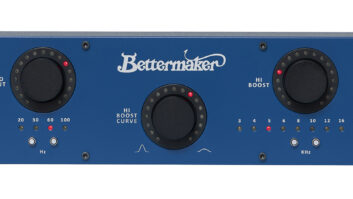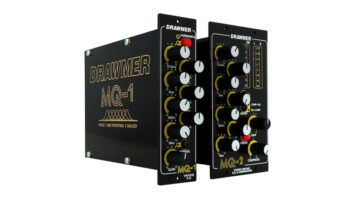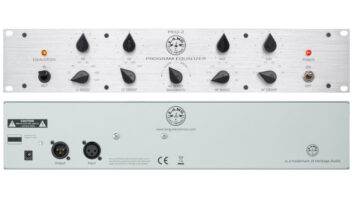Seemingly, everyone already knows all about equalizers. Their effects are easily heard. Their settings are easily understood. And in an industry that’s barely able to formulate standards, the equalizer stands out as the industry’s most consistent device. Every professional graphic EQ has the same frequencies. Operation is a snap, and an engineer with only minimal ear training can get a feel for pushing the right sliders up and down. By comparison, digital processors seem endlessly complex.
So why are equalizers shrouded in mystery, vaguely understood and often poorly operated? Why do equalizers with identical front panel settings sound so different? Why the 10:1 difference in price for devices with identical features? Why is everyone concerned about the phase response when not a single unit on the market offers independent user control of that parameter? Why do we have such a love/hate relationship with equalizers? (Engineers wouldn’t dream of leaving their equalizers in the truck, but they feel deep satisfaction if they do not have to use them.) Most importantly, why are the results so often disappointing?
What is underneath all this? Could it be that the front panel settings of most equalizers are not representative of the actual curve being created? Could the difference in price (and sound quality) among seemingly identical units simply be a result of the quality of the parts inside, internal gain structure and reliability, rather than more costly units having altogether different circuit topologies?
Perhaps engineers’ mixed feelings about equalizers are related to the possibility that the wrong type of equalizer is used for most applications. The problem is complicated by engineers trying to use EQ to solve problems that are better handled by delay lines, volume controls, speaker positioning, room acoustics modification or just merely correct system wiring. Let’s dig deeper…
THE RIGHT TOOL FOR THE JOB
The first rule in choosing an equalizer is selecting the proper tool for the job. Since there are only two basic types of tools (graphics or parametrics) and only two types of jobs (tone control or system alignment) this should not be difficult. Tone control refers to the artistic touch-up of the system’s response, as might be done by the mix engineer to tailor the response of the system to taste; this is done by ear or perhaps aided by low-resolution instrumentation such as a real-time analyzer (RTA). System alignment, on the other hand, is a scientific process where the interactions of the speakers and the room are compensated for by carefully adjusting delay, levels and finally, equalization. This procedure is best done with instrumentation capable of precisely displaying amplitude, phase and signal-to-noise. This distinction is important: Broad strokes are better for artistic tone control, whereas system alignment requires precise filter locations and shapes.
As all three parameters (frequency, level, bandwidth) on parametric EQs can be adjusted, their filters can be shaped for any type of response. The main limitation is the number of filters available, which is simply an economic issue. Graphic EQs, on the other hand, are hobbled by fixed filter frequency and fixed bandwidth, a limitation so severe that they can really only be used as tone controls. In short: A parametric EQ can match any curve that a graphic can dish out, but a graphic cannot come close to creating the response of a parametric. Most importantly, however, the parametric can create the inverse of any equalizable problem that speakers and rooms can dish out.
Unfortunately for graphic equalizers, the anomalies of speaker interactions in a room do not often occur at ISO standard center frequencies, nor do they only present themselves at a single fixed bandwidth; the probability that a graphic EQ can create the inverse response of speaker system interaction is practically zero. Graphics used for system alignment are incapable of accurately suppressing peaks due to errors in center frequency and bandwidth. This leads to a prevalent industry myth that graphics are filled with mysterious phase problems. All sorts of arcane rules of thumb prevail about how far you can cut on a graphic and what you should do with neighboring faders. It is all misguided. The actual problem is much simpler than that: The amplitude and phase responses are off the mark, and the results are horrendously audible.
BANDWIDTH: A DECISIVE PARAMETER
Graphic equalizers are “constant-Q” devices, where each filter has the same percentage of an octave bandwidth as the next. Few people realize, however, that the standard for graphic EQs refers only to the spacing of the center frequencies, and not the bandwidth of the individual filters. Depending on the model, the width of the filters can vary from a full octave to 11/46 octave. Two units with identical visual settings can sound radically different due to the interaction of adjacent filters. Some models may even change filter bandwidth when you change the gain range setting (without telling you, of course).
Parametric equalizers can be confusing, as many units on the market use asymmetrical filters: If set to boost, the filter is wide, but when set to cut, it becomes a narrow notch filter. For example, a user with a trained ear can sweep a boost filter and locate the approximate center frequency of a problem area, and then adjust the bandwidth to feel how wide the affected area is. But when the filter is moved into a cut mode, the bandwidth totally changes. Once again, what you see is not what you get.
THE PHASE MYSTERY
There is no shortage of discussion regarding the phase of equalizers. Phase is, of course, the invisible enemy to all but the few who have access to high-tech analysis equipment (and know how to read it). In some cases I have seen engineers apply simplistic logic: If adjusting the amplitude cannot solve the problem, then it must be a phase problem. In some cases this is true-for example, when the speakers are wired wrong or there is a delay between components. But in the case of the misapplied graphic equalizer, it is simply impossible to correctly locate and shape the filter’s response to fix the problem-even when an equalizer is the right tool. The harder you try (with more filters and deeper cuts) the worse it gets, because the amplitude response gets further off target as the filters interact with each other. The phase response does indeed worsen, but only because it is tied to the amplitude response of incorrect filters.
Even if you invented a graphic equalizer with phase response that was somehow different from any on the planet, or perhaps had no phase shift whatsoever, it would still be an ineffective tool for system alignment because it can control only one parameter per filter-the boost or cut.
The quest for a “phase perfect” equalizer is a futile search for the Holy Grail. A common misconception is that an EQ with no phase shift would be better than one that follows the normal laws of physics where the phase response is the first derivative of the amplitude. This belief has found a new life in the world of ultimate fantasy: digital EQs. ALL filters have a phase component and create shift proportional to steepness, regardless of whether they’re derived in the analog or digital domain. Even if a “phase-perfect” filter could be found, it would not work well for system alignment anyway, since in order to create the inverse of the response created by speaker and room interactions, we must introduce equal and opposite amplitude AND phase response.
COMPARING MODELS
How can we tell if one equalizer is better than another? First we have to define the application. If the EQ will be used for artistic control, then either a parametric or graphic can be used. Since this application is primarily creative, it makes sense to judge these EQs using artistic criteria, running them through the full range of adjustments while listening to music. Units with wider bandwidths are generally perceived as more musical. Exercise several faders together: Wide filters produce interaction with their neighbors, creating the desirable sound of a single plump, smooth filter. Narrow filters combine when adjacent faders are moved together to create an audible ripple response that is unsuitable for tone controls. Feedback control is another issue, but we’ll save a rant on the misuse of graphics in monitor systems for another time.
Be sure to exercise both the boost and the cut side of an equalizer. Filters may sound different as you move the slider from boost to cut if their response is not symmetrical. For alignment applications, you must be assured that the device can create the required curves. The frequency and bandwidth must be continuously selectable (not stepped). The bandwidth should be adjustable from 0.1 to 1 octave in both boost and cut. Unfortunately, judging the range of a filter’s response without accurate measurement instrumentation can be difficult.
One key to sonic quality is distortion. Cheap EQs use cheap capacitors and op-amps in the signal path. Good ones use high-quality capacitors, which cost real money. The difference is distortion. To test this you will need to make sure that the filter is inserted and placed in a cut and then in a boost mode. The good ones have noticeably better distortion specs. Cheap digital equalizers use cheap A/D converters. Same problem: noise and distortion. Once again, measure with filters inserted, since the bypass switch may actually bypass the A/D converters.
Internal gain structure is an important factor. Cheap EQs have great signal-to-noise specs until you take them out of bypass. A popular design trick is to add gain before the filters and then attenuate the signal just before the output, leaving a perceived unity gain. This costs you 10 to 20 dB of headroom, but allows the EQ to hide filter noise. In particular, watch out for this in digital devices. You can observe this by feeding the device a high level (+20dBu) sine wave while the unit is in bypass. Then switch the filters back in and observe. If the unit goes into distortion even with the filters zeroed at unity, you know that you have a pseudo-unity device. Like most things in life, you get what you pay for-if it’s really cheap, then it’s really cheap.
Can you hear all these differences? Try a simple comparison the next time you set up in stereo, using your old EQ on one side and something newer or possibly more expensive on the other. Now listen and try duplicating your old sound on the new unit. Can you do it? To simulate louder applications, turn your amps down and compare the EQs when the music is going through them full-tilt boogie.
Equalizers are simple but limited tools, however all your sound passes through one. And although they tend to be fairly simple devices, their role is critical. If the right tool is chosen for the job and operated properly, predictable improvements in the sound can result. Once you’ve heard the difference a correctly adjusted quality equalizer can make, you’ll no longer take your EQ for granted. Don’t you wish the rest of your system was this easy to improve?






